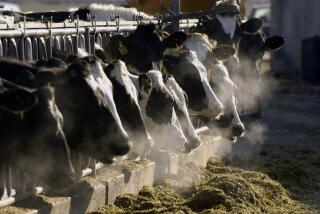Two condor deaths in Kern water tanks are major blow to species
- Share via
The deaths of two California condors found last month in water tanks used by Kern County firefighters have state wildlife officials working on a way to keep the large, endangered birds out of the tanks.
California wildlife officials have sent the condor carcasses to a forensics lab in Oregon for necropsies to determine how the birds died. But with so few in the wild, experts called the loss a blow to a still-fragile recovery program.
There are a little more than 100 condors living in the wild in California after what few remained were captured in an effort to bring the species back from the brink of extinction in the 1980s.
“To lose one is significant, and now, two deaths. It’s a blow to recovery,” said Kim Delfino, director of Defenders of Wildlife California Program.
The condors were discovered roughly two weeks apart in open-air tanks that store water during the wildfire season for firefighting helicopters, officials said. The helicopters suck in water by dropping lines down into the tanks while hovering above. With the fire season over, both tanks, which are 12 to 15 feet in diameter and at least 3 feet deep, were recently emptied, said Sean Collins, a Kern County Fire Department spokesman.
The first condor was found Oct. 2 by wildlife officials after the bird’s transmitter signal changed, which occurs when a condor remains stagnant for at least 12 hours. When that happened, “we began a search,” said Joseph Brandt, supervising wildlife biologist for the U.S. Fish and Wildlife Service’s California Condor Recovery Program.
All California condors released into the wild are outfitted with the transmitters so scientists can track their movements.
Kern County firefighters found the second condor during “The Great California Shakeout” training for earthquake readiness on Oct. 17.
Officials didn’t immediately know how the condors ended up in the tanks located in Kern County’s Bear Valley Springs and Stallion Springs in the Tehachapi region.
“They both appeared to be in the tank for a number of days,” Brandt said. “They were pretty decomposed.”
Officials with the condor program and the Kern County Fire Department are now exploring ways to prevent similar incidents before the next wildfire season begins and the tanks are refilled with water.
The condors have a historical connection to the Tehachapi Mountains where they recolonized in the last five years. The area provides an ideal habitat, experts said, with large-branched trees for dwelling and a good source of food for the large birds that rely on carrion, predominantly in hunting areas.
But their diet puts them at particular risk of lead poisoning if the carcasses they consume have been shot with lead bullets.
Including the Kern County finds, three condors have died in California so far this year, one from lead toxicity, according to the Los Angeles Zoo and Botanical Gardens. Twenty-one condors were treated for lead toxicity at the zoo in October, a one-month record.
The zoo’s announcement came just weeks after Gov. Jerry Brown signed legislation requiring hunters to use non-lead ammunition in an effort to keep the toxic element from being passed on from carcasses to scavengers, such as condors.
“A lot of time and effort goes into each individual bird and it’s never a good thing to hear about another dead condor,” said Steve Kirkland, who works on condor rehabilitation programs for the U.S. Fish and Wildlife Service, in an email. “While the loss of the two birds to the recent drownings is a setback, the larger cause of mortality, and the primary threat to the recovery, of the species is lead poisoning.”
More to Read
Sign up for Essential California
The most important California stories and recommendations in your inbox every morning.
You may occasionally receive promotional content from the Los Angeles Times.











